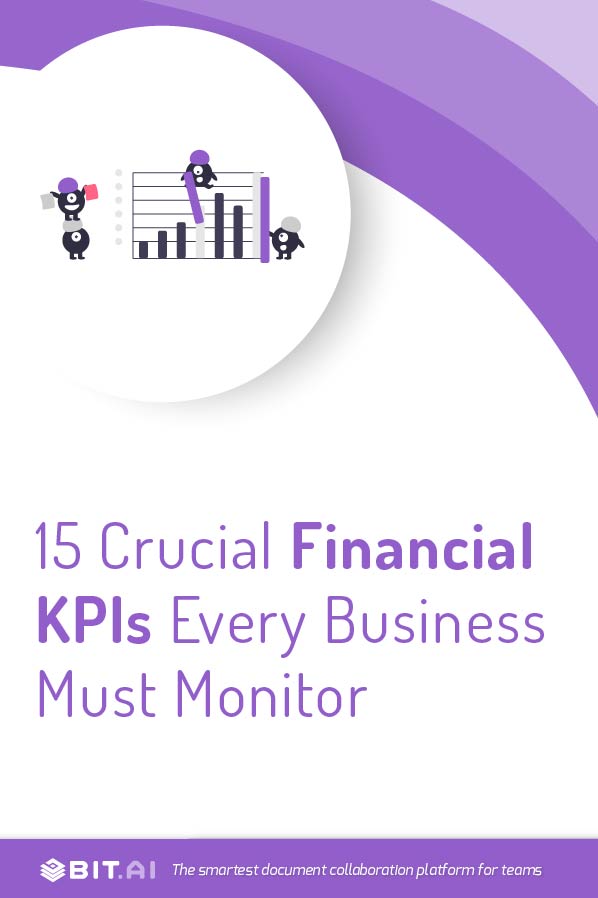How often do you check up on the financial health of your business?
No, we are not just talking about looking at the profits of your company alone. We mean the full picture and that includes everything from your net profits to sales figures to inventory to customer satisfaction and more!
Most people in business just check their company’s net income at the end of the month and then try to come up with ways to expand their business.
But if you really want an effective way to grow and expand your business, then you need to have a clear understanding of the financial well-being of your company. For that, you need to be tracking financial metrics and financial key performance indicators (KPIs).
If you are wondering what that means, then don’t worry. This blog will help you understand everything you need to know about financial KPIs so that you can make better financial decisions.
Ready? Let’s go!
What are Financial KPIs?
Let’s start with what KPI means.
KPI is short for key performance indicator, which is a numeric value that measures the performance of your company. It indicates whether your company is making any progress or development with its targets.
So, financial key performance indicators or financial KPIs measure the overall financial performance of your company.

They provide you with all the information you need to know about the expenses, sales, profit, and cash flow of your business so that you can make decisions that will help you achieve all your financial goals and objectives.
Why You Should Track Financial KPIs?
Let’s face it, you cannot kid around when it comes to finances. Your business functions for the primary purpose of earning profits. So, it is important that you track your company’s financial health if you are really serious about earning money and expanding your business.
That’s why financial KPIs exist – they are indicators that give you quantifiable measures about your company’s financial health!
You must always keep an eye out for them if you really care for your business because:
- They provide fact-based and numerical metrics of your company’s financial performance
- Helps you evaluate the success of your company
- Spots the areas in your business that needs improvements
- Helps you predict your company’s future profits and revenues
- Prepares your firm to face any problems or risks that might arise
- Successfully compete with other companies and industries
- Improve the overall financial health of your company through increased revenues
By understanding financial KPIs, you can be in a better position to know about how your business is performing from a financial perspective.
They are everything you need to accomplish your financial goals!
Want to know more about financial KPIs?
Then grab a pen and paper because we are going to dive into a list of financial KPIs you should be tracking to help you understand your company’s financial health!
Let’s go!
Read more: Top 7 HR KPIs You Should Measure in 2022!
List of Financial KPIs You Should Be Tracking:
1. Operating Cash Flow
Operating cash flow is the calculation of the total amount of money generated from a company’s daily business operations. It includes all the inflows and outflows connected to your business activities such as revenues (from sales, refunds, etc.) and expenses (salaries, fines, fees, etc.).
It is a financial KPI that gives you a deeper insight into your company’s financial health by revealing whether your business operations are making enough cash flow for further capital investments to maintain or grow your operations.
2. Gross Profit Margin
If there’s a financial KPI that you need to track to understand the financial status of your business, then it’s your Gross Profit Margin. It is simply the total revenue of your company minus the cost of goods sold (the direct expenses associated with your product).
When you analyze the gross profit margin, it tells you whether you have priced your products appropriately or not and whether you have created a product that is better than your competitors. It’s an easy way to measure your company’s profitability and also its production efficiency over the years.
3. Net Profit Margin
If you want to know how well your business is doing at turning revenue into profits, then Net Profit Margin is your financial KPI for it. Your net profit is the amount of cash left after you have paid all your direct and indirect expenses. This divided by your total revenue is your net profit margin.

It measure how effective your business has been in converting your revenue into profits. It also shows your firm’s potential net worth based on your earnings and also predict your future profits.
The higher your net profit margin, the better off your business is.
4. Working Capital
Working capital is the difference between your company’s current assets such as cash, accounts receivable, etc. and your current liabilities such as loans, accounts payable, etc. It reflects your company’s available assets that can cover your short-term financial commitments.
Working capital is a great financial KPI because it can measure your company’s operational effectiveness and efficiency and also helps you identify any money-related issues before you run into financial troubles. This in turn helps you in financial reporting and analysis.
A high working capital doesn’t mean your company is doing well as it can also mean that you are not investing your extra cash.
Read more: 12 Sales KPIs Your Sales Department Should Measure!
5. Current Ratio
How do you know if your business is in a position to meet all its financial obligations on time? You calculate its current ratio. It is an important financial KPI that determines your company’s short-term financial health and tracking it may give you a warning of cash flow problems.
It is calculated by dividing your current assets such as cash, inventory, prepaid expenses, etc. by your current liabilities such as accounts payable, credit card debt, taxes, etc. It measures your company’s ability generate enough to pay off any debts.
The higher your current ratio, the more capable you are of paying your bills in the short-term.
6. Quick Ratio
Next on the list is the quick ratio, an extremely important financial KPI that assesses the financial health and wealth of your business. It is also known as the acid test ratio because it produces instant results.
This KPI is stronger than the current ratio because it does not include assets that are not liquid such as inventory. This means that it measures your firm’s immediate liquidity and cash-on-hand to meet short-term financial liabilities. So, if your quick ratio is smaller than your current ratio, it means that your current assets depend on your inventory.
The higher your quick ratio, the better your liquidity and financial health.
7. Return on Equity
If you have shareholders, then return on equity is a great financial KPI that lets you compare your company’s profitability with its competitors and assess its financial standing in the industry. It indicates how much profit your company generates with your shareholders’ investments in your business.
Return on equity KPI is calculated by dividing your company’s net income by your shareholder’s equity. This lets you measure your organization’s profitability and quantifies its operational and financial management efficiency.
The bigger the return on equity, the more efficient your business is.
8. Return on Investment
Return on Investment (ROI) is one of the most frequently used financial KPIs in business because it extremely simple and flexible. It is a measure of the money gained from an investment compared to the amount of money invested. Essentially it tells you whether your investment was worth it.
ROI can be used to evaluate your company’s profitability and efficiency in regard to the investments you make. It also helps calculate worth of money into a particular project and helps you choose the best investment options for your company.
9. Burn Rate
Burn rate is an extremely relevant financial KPI if you have a small business. It is the rate at which your company spends money within a definite period of time even before it can produce a positive cash flow. In short, it is the cash you spent per month.
This KPI indicates your monthly spending and helps you determine how much cash your company needs to continue operating and growing. It also calculates the amount of time your company has before it runs out of money and helps make the necessary plans for fundraising or cutting costs.
10. Accounts Payable Turnover
What if you could find out if your company is doing a good job at paying off its suppliers? Accounts payable turnover does just that! It divides the total cost of sales during a period with your average accounts payable for that period. This lets you measure the rate or speed at which you pay off your suppliers.
This financial KPI lets you track the time your company takes in completing your payments so that you can take the necessary actions to maintain your standing with your vendors. This also indicates the number of times your company has paid off its accounts during a fixed course of time, thus helping you understand your company’s financial health.
11. Accounts Receivable Turnover
The accounts receivable turnover indicates the rate at which your business collects payments due from its customers. It is calculated by dividing your total sales for a period by your average accounts receivable for that period.
It’s a great financial KPI that alerts you to make changes in managing receivables to bring payments within proper time and also helps you measure how effectively your company is able to extend credit to clients. The higher the ratio for your accounts receivable turnover, the better it is for your company as it is an indication that your customers are paying you faster.
12. Inventory Turnover
It may be hard to keep track of your inventory as it is something that continuously goes in and out of your warehouse. That’s why keeping track of it will help your company’s sales strength and production efficiency. The inventory turnover KPI helps you do this by measuring your firm’s ability to sell and re-stock its inventory during a particular time period.
It is an excellent financial KPI because it indicates the efficiency of your supply chain, the quality and demand of your inventory, and the fairness of your buying practices. It also helps you determine how organized and efficient your business is in controlling merchandise and how great it is at generating sales and increasing revenue.
13. Debt-to-Equity Ratio
The debt to equity ratio presents the total liabilities of your business with your shareholders’ equity. It measures how well you are utilizing your shareholder’s investments and how much of your financing and growth is dependent on borrowings or debts.
It is a critical financial KPI because it helps you get insights into your business’ equity and liability, and helps you focus on your financial accountability. A lower debt to equity ratio means that your company does not rely on its shareholder’s equity or creditors for financing debts.
14. Budget Variance
Budget variance is the difference between the budgeted or allocated figures and the actual figures for a specific accounting category. This difference could be due to factors such as poor budget planning, changing business conditions, natural disasters, labor costs, etc.
This financial KPI is used to evaluate whether your budgeted amounts meet your expectations and help you plan your budgets keeping in mind the various internal and external factors that influence them.
15. Customer Acquisition Ratio
Your customers easily help you understand the financial health of your business, after all, your business depends on them. That’s why the customer acquisition ratio is a great financial KPI that you should keep an eye out for. It helps you measure how much revenue you receive for each new customer you acquire.
You can calculate your customer’s expected lifetime profit with the cost of acquiring them. If the acquisition ratio is below one, then it’s a loss for your business, but if it’s higher than one, then it means that your investment was worth it and you are increasing your company’s revenue.
Conclusion
Who knew there would be so many financial KPIs, right?
But, if you noticed, they are all very different. That’s because each financial KPI caters to the needs of different types of businesses. So right now it is up to you to make the right decision for your business.
Choose the ones that fit your needs!
Go! Get started on tracking your finances!
Good luck!
Further reads:
Annual Report: What is it & How to Create it?
Personal Financial Statement: What is it & How to Create a Solid One?
Top 10 Financial Tools for Businesses in 2022!
KPI Dashboard: Definition, Tools, and Tips!
Company Profile: What is it & How to Create it?
KPI Report: What it is & How to Create a Perfect One?
Brand Authenticity: Definition, Importance & Tips To Build It!
12 Marketing KPIs Every Marketing Team Should Monitor!
11 Budgeting Tools & Software to Keep Track of Business’s Budgets!
Management Report: What is it & How to Create it?
6 Crucial Financial Documents For Every Organization!
OKRs Vs. KPIs: Breaking Down The Types and Differences!



